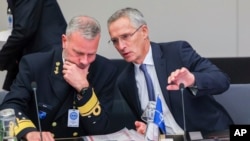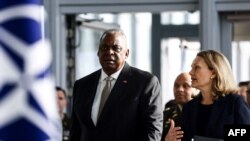Ukraine’s defense minister is set to brief the latest meeting of the U.S.-led Ukraine Defense Contact Group in Brussels on Wednesday, with NATO defense ministers also meeting there to discuss how to support Ukraine in its battle against a Russian invasion.
NATO Secretary-General Jens Stoltenberg told reporters Tuesday that the talks will provide an opportunity for Ukraine to present a list of what it needs and see how that matches up with what partner countries can provide.
Stoltenberg said the meeting comes at a “pivotal moment for our security” with the last few weeks bringing “the most serious escalation of the war since the invasion in February.”
He said NATO allies send the message that they are ready to support Ukraine “for as long as it takes.”
Leaders of the Group of Seven major industrial nations, meeting in a crisis video conference with Ukrainian President Volodymyr Zelenskyy on Tuesday made the same pledge after Russia continued its barrage of missile attacks on Ukrainian cities.
The G-7 leaders said in a statement after the virtual meeting that they had reassured Zelenskyy they are “undeterred and steadfast in our commitment to providing the support Ukraine needs to uphold its sovereignty and territorial integrity.” They said Moscow’s “indiscriminate attacks on innocent civilian populations constitute a war crime.”
“We will hold President [Vladimir] Putin and those responsible to account,” the G-7 leaders said. The G-7 comprises U.S., Germany, Britain, France, Italy, Canada and Japan.
Amid Putin’s ongoing threats to use nuclear weapons, the G-7 reiterated it would direct “severe consequences” should Moscow use weapons of mass destruction, but did not imply direct military involvement in Ukraine.
U.S. officials have said they have not seen indications that Putin has decided to use nuclear weapons and underscored there is no change in U.S. nuclear posture.
John Kirby, the National Security Council coordinator for strategic communications, told VOA in a briefing to reporters Tuesday that the U.S. is not considering deploying tactical nuclear weapons — smaller and less destructive than strategic nuclear weapons — in Ukraine.
“There's absolutely zero interest from our side and from our allies and partners to see this war escalate into the use of the weapons of mass destruction at all,” he said.
Russia is estimated to have 2,000 of these tactical nuclear weapons, including some so small and portable that they are referred to as “suitcase bombs.”
“It's unclear whether we have the ability to track how Russia is moving or not moving their tactical nuclear weapons,” Luke Coffey, a senior fellow at Hudson Institute, told VOA. “We have to plan for all contingencies.”
White House press secretary Karine Jean-Pierre declined to comment on reports that President Andrzej Duda of Poland has offered to participate in a nuclear-sharing agreement in which his country would host nuclear arsenals.
Air defense systems
Earlier this week, President Joe Biden told Zelenskyy the U.S. would provide Ukraine with advanced air defense systems, according to the White House.
The air defense systems under consideration would include those that can counter so-called loitering munitions, which wait around an area and attack once a target is located. These include drones that Russia recently obtained from Iran, said Becca Wasser, senior fellow in the defense program at the Center for New American Security.
“To ensure that, frankly, Ukraine can have better control of its airspace, not only for some of its military operations but to assure that it won't actually have some of these attacks on civilians and on some critical infrastructure,” Wasser told VOA.
These systems are necessary to create a sense of normalcy within the country, now in its eighth month of Russian attacks, Wasser added.
“To make it so that folks are willing to return to places like Kyiv and ensure that Ukraine can actually restart its economy,” she said.
The White House would not elaborate on the kinds of systems it is considering for Kyiv, including whether they would deploy the long-range Patriot air defense system that can counter tactical ballistic missiles, cruise missiles and advanced aircraft.
“We have provided air defense systems to Ukraine,” Kirby said. “We plan to continue to provide air defense systems to Ukraine. And when there's something to announce in that regard, we'll do that,” he said during the briefing.
Monday’s strikes, which included 84 cruise missiles and 24 drones, killed at least 19 people. Moscow said they were in response to an attack Saturday on a bridge that links Russia to Crimea, the Ukrainian peninsula illegally seized by Moscow in 2014, which has been a major supply route for Moscow’s operations in southern Ukraine. Ukraine has hinted its security agents carried out the truck bomb attack on the bridge but has not publicly claimed responsibility.
Russian Ambassador to the United States Anatoly Antonov told reporters that more Western military aid for Ukraine risked further escalation and a possible clash between Russia and NATO.
Tougher sanctions
The G-7 said it is committed to helping Ukraine meet its “winter preparedness needs” and will continue to provide financial, humanitarian, military, diplomatic and legal support to Kyiv.
Zelenskyy urged the Western allies to impose even tougher sanctions on Russia’s energy sector to stop the flow of money from its oil and gas exports, which Moscow uses to help fund the war. It would be a symmetrical response to Russia’s attacks on the “energy sector and energy stability of our countries,” he said.
G-7 leaders also condemned the involvement of Belarusian President Aleksandr Lukashenko after more than two dozen missiles were fired at Ukrainian targets from the country, calling it “the most recent example of the Belarusian regime's complicity with Russia.”
The G-7 focus on Belarus is “a good first step,” because for too long, Lukashenko has received a pass on the Russian invasion, according to the Hudson Institute’s Coffey.
On Monday, Lukashenko announced Russian troops would return to Belarus in large numbers, a replay of the military buildup there prior to Moscow’s invasion of Ukraine in February.
Ken Bredemeier, Megan Duzor, and Chris Hannas contributed to this report.










